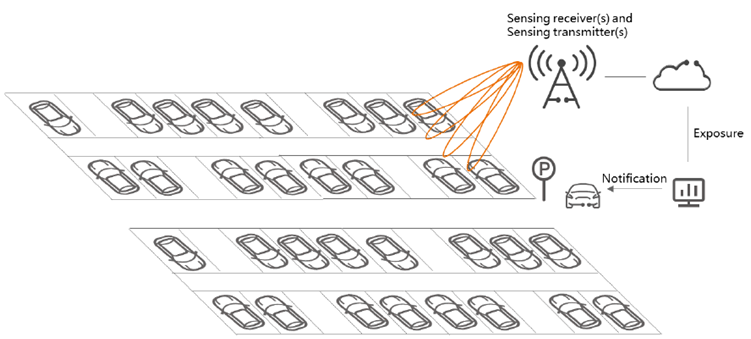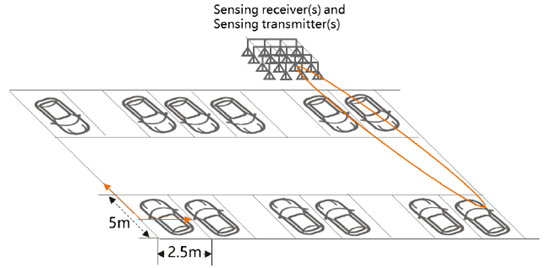Content for TR 22.837 Word version: 19.3.0
0…
4
5…
5.2…
5.3…
5.4…
5.5…
5.6…
5.7…
5.8…
5.9…
5.10…
5.11…
5.12…
5.13…
5.14…
5.15…
5.16…
5.17…
5.18…
5.19…
5.20…
5.21…
5.22…
5.23…
5.24…
5.25…
5.26…
5.27…
5.28…
5.29…
5.30…
5.31…
5.32…
6…
7…
5.20 Use case of Sensing for Parking Space Determination
5.20.1 Description
5.20.2 Pre-conditions
5.20.3 Service Flows
5.20.4 Post-conditions
5.20.5 Existing features partly or fully covering the use case functionality
5.20.6 Potential New Requirements needed to support the use case
...
...
5.20 Use case of Sensing for Parking Space Determination p. 59
5.20.1 Description p. 59
Sensing technology can improve the user experience in parking garage via enabling the vehicle and parking garage to get more information, e.g. information whether a parking space is available or not. The indoor/underground parking garage can install multiple Sensing receivers and Sensing transmitters throughout the concrete structure for detecting the availability of the parking space. The outdoor parking garage can also exploit multiple Sensing receivers and Sensing transmitters for detecting the availability of the parking space.
Another related use case is automated parking e.g. AVP (Automated Valet Parking) and AFP (Automatic Factory Parking) [45] where cars are provided with drive-path information to do automated parking in a given parking lot facility. Connectivity is an important component in automatic parking, and the 3GPP sensing technology can serve as the way to determine available parking spaces and the best route for a car to reach it.
The coverage could be either a public network or a private network specifically for the parking garage. For the Sensing receiver(s) and Sensing transmitter(s) indoor, see Figure 5.20.1-1, one deployment scenario is that Sensing receiver(s) and Sensing transmitter(s) can be ceiling-mounted and located in such a way as to provide sensor coverage for the parking bays within the structure, where the Sensing transmitter and Sensing receiver can be co-located. Another deployment method is that some Sensing receiver(s) and Sensing transmitter(s) can be ceiling-mounted and some can be mounted on the floor or wall, where the Sensing transmitter and Sensing receiver can be separately located. For the Sensing receiver(s) and Sensing transmitter(s) outdoor, see Figure 5.20.1-2, Sensing receiver(s) and Sensing transmitter(s) can be deployed at a relative high place to guarantee the coverage of the parking garage.


Multiple methods can be used via using the sensing signals emitted from the Sensing transmitter to detect the target object/area and the sensing signals bounced/reflected. For example, the Sensing receiver can measure the reflected signal power of the target area [8]. Since the cars are usually made of metal materials and the ground is, on the contrary, covered by cement or plastic cement, these objects can vary significantly on the reflected signal power, thus the Sensing receiver can distinguish whether a parking space is taken by simply measuring the reflected signal power difference. Another example method is that the Sensing receiver(s) and Sensing transmitter(s) can identify a parking space availability by monitoring the target movements. Comparing with the stationary objects such as ground and poles, the Sensing receiver(s) and Sensing transmitter(s) can easily distinguish a car when a car is parking or leaving, thus by measuring the distance/angle/velocity, the Sensing receiver(s) and Sensing transmitter(s) can record that a parking space is occupied when a car is parking, and that a parking space is free when a car is leaving. Or the Sensing receiver(s) and Sensing transmitter(s) can also detect a parking space availability by generating a 3-D point cloud [9], then both the stationary and moving target can be easily detected in a 3-D point cloud especially with some backend data processing skills such as machine learning/deep learning.
5.20.2 Pre-conditions p. 61
This use case is about a public multi-storey parking garage who has installed Sensing receiver(s) and Sensing transmitter(s) throughout the concrete structure to detect the positions of people, objects, and vehicles within the garage. The concrete structure can make coverage difficult and, especially in underground levels, coverage provided by external transmitters can be very poor. This parking garage can provide the information to the entering vehicles about the availability of the parking space.
Consider an example scenario shown in Figure 5.20.2-1. A typical parking space is with length 5 m and width 2.5 m. So, from the horizontal dimension, the resolution requires to distinguish different parking spaces. The results can be aggregated by the parking garage operator and the parking state can be updated in seconds even when the coverage of the parking garage is poor, which helps avoid a wasting of time for the entering vehicles.

5.20.3 Service Flows p. 61
- James wants to park his car at the public parking garage in floor #B2. His vehicle, on entering the public parking garage, queries the parking garage service for availability of a parking bay in floor #B2.
- The parking garage operator can activate the sensing devices in floor #B2 for sensing. Sensing receiver(s) and Sensing transmitter(s) sense the parking spaces without interfering each other or with bearable interference. The sensing results can be aggregated by the parking garage operator.
- With the aggregated sensing results, the parking garage operator can send sensing results back with an addition to the dynamic map corresponding to the floor #B2 which shows the current status of parking bays in the structure.
- James can see the available parking bays on his in-car display and choose a suitable one.
5.20.4 Post-conditions p. 61
Thanks to sensing, James has found a parking space on the correct floor without issue, making his life easier during daily travel.
5.20.5 Existing features partly or fully covering the use case functionality p. 61
None.
5.20.6 Potential New Requirements needed to support the use case p. 61
[PR 5.20.6-1]
The 5G system shall be able to provide sensing services in licensed and unlicensed spectrum.
[PR 5.20.6-2]
The 5G system shall be able to authorize Sensing receiver(s) and Sensing transmitter(s) to participate in a sensing service.
[PR 5.20.6-3]m
Based on operator's policy, the 5G system shall enable a trusted third-party to request the activation of the sensing service with specific KPI requirement, as well as deactivation of the same service.
[PR 5.20.6-4]
The 5G system shall be able to support charging for the sensing services (e.g. considering service type, sensing accuracy, target area, duration).
[PR 5.20.6-5]
The 5G system shall be able to provide a sensing service considering the interference to the Sensing service caused by the sensing operations between multiple Sensing transmitter(s) and Sensing receiver(s).
[PR 5.20.6-6]
The 5G system shall be able to provide sensing with following KPIs.
| Scenario | Sensing service area | Confidence level [%] | Accuracy of positioning estimate by sensing (for a target confidence level) | Accuracy of velocity estimate by sensing (for a target confidence level) | Sensing resolution | Max sensing service latency [ms] | Refreshing rate [s] | Missed detection [%] | False alarm [%] | |||
|---|---|---|---|---|---|---|---|---|---|---|---|---|
| Horizontal
[m] |
Vertical [m] | Horizontal [m/s] | Vertical [m/s] | Range resolution [m] | Velocity resolution (horizontal/ vertical) [m/s x m/s] | |||||||
| Parking space determination | Indoor/ outdoor | 95 | 0.5 | 0.5 | 0.1 | N/A | 2.5m perpendicular to the parking space 5m parallel to the parking space | N/A | 1000 | 1 | 1 | 5 |
|
NOTE:
The terms in Table 5.20.6-1 are found in clause 3.1.
|
||||||||||||